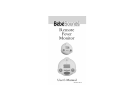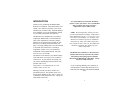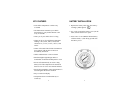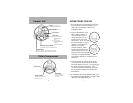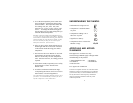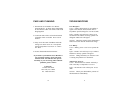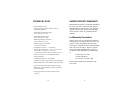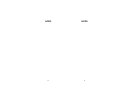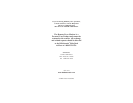
8
9
• Information is being received
• Temperature is under the alarm
set point
• Temperature reading is at or
above the set point
• Signifies low battery
• Temperature above or below the
Monitor’s range
5. To set the alarm push the power button and
the LCD display will flash an alarm setting
and read “SET.” The temperature alarm has
five settings: 98°, 99°, 100°, 101°, and
102°F/36.7°C, 37.2°C, 37.8°C, 38.3°C, and
38.9°C. To change the alarm setting press
the (S) button once for each setting until you
reach the desired temperature.
Remember, temperature readings taken abdominally may be
.7°~1.4°F (.4°C~.8°C) lower than rectal readings. This differ-
ential should be considered when monitoring your child’s tem-
perature and when you set the alarm. For example, you may
want to set the alarm for 100 if you want to know if your
child’s fever reaches 101. (See Note on P. 3)
6. After you have set the alarm push the power
button again and the LCD screen will return
to the monitor mode showing your child’s
temperature.
7. The first time the Fever Monitor is used wait
approximately 20 minutes for the thermo-
meter to reach a fully accurate temperature
read. After the first time, no waiting period is
required.
8. If the alarm sounds, temporarily turn it off by
depressing the “Cancel” button on the
Parents’ Unit.
9. To achieve maximum transmission range,
avoid placing the Parents’ Unit on or close to
metal articles or electrical appliances.
Use of the Remote Fever Monitor should not replace a visit to
your doctor. It is recommended that you advise your doctor
any time a temperature is above 100°F/37.8°C.
LO/HI
APPROVALS AND APPLIED
STANDARDS
FDA approved. For home use only.
The following standards apply to design and/or
manufacturing of the product:
• ASTM Standard E 1112 • EN 60601-1
• EN 60601-2 • ETSI300-683
• ETSI 300-220
FCC Approved: OV4RT910
This device complies with Part 15 of the FCC Rules.
Operation is subject to the following two conditions:
(1) This device may not cause harmful interference,
and (2) This device must accept any interference
received, including interference that may cause
undesired operation.
UNDERSTANDING THE SYMBOLS



